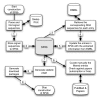SPdb--a signal peptide database
- PMID: 16221310
- PMCID: PMC1276010
- DOI: 10.1186/1471-2105-6-249
SPdb--a signal peptide database
Abstract
Background: The signal peptide plays an important role in protein targeting and protein translocation in both prokaryotic and eukaryotic cells. This transient, short peptide sequence functions like a postal address on an envelope by targeting proteins for secretion or for transfer to specific organelles for further processing. Understanding how signal peptides function is crucial in predicting where proteins are translocated. To support this understanding, we present SPdb signal peptide database http://proline.bic.nus.edu.sg/spdb, a repository of experimentally determined and computationally predicted signal peptides.
Results: SPdb integrates information from two sources (a) Swiss-Prot protein sequence database which is now part of UniProt and (b) EMBL nucleotide sequence database. The database update is semi-automated with human checking and verification of the data to ensure the correctness of the data stored. The latest release SPdb release 3.2 contains 18,146 entries of which 2,584 entries are experimentally verified signal sequences; the remaining 15,562 entries are either signal sequences that fail to meet our filtering criteria or entries that contain unverified signal sequences.
Conclusion: SPdb is a manually curated database constructed to support the understanding and analysis of signal peptides. SPdb tracks the major updates of the two underlying primary databases thereby ensuring that its information remains up-to-date.
Figures


References
-
- Nobel Prize in Physiology or Medicine 1999 http://nobelprize.org/medicine/laureates/1999/
-
- SIG-Pred: Signal Peptide Prediction http://www.bioinformatics.leeds.ac.uk/prot_analysis/Signal.html
-
- SIGFIND - Signal Peptide Prediction Server (Eukaryotes) http://139.91.72.10/sigfind/sigfind.html
MeSH terms
Substances
LinkOut - more resources
Full Text Sources
Other Literature Sources

